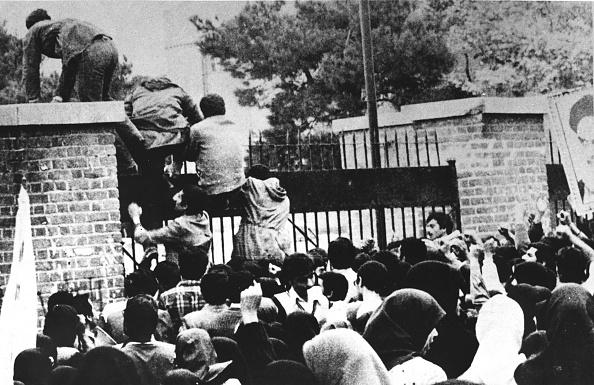Iran on Nov. 4 marked the 43rd anniversary of the seizure of the U.S. Embassy in Tehran by pro-revolution Iranian students.
The incident, which occurred immediately after the country’s 1979 Islamic Revolution, kicked off decades of hostility between Iran and the United States.
Large pro-government rallies were held on Nov. 4 in several parts of the country to mark the anniversary. Images broadcast on Iranian state television showed tens of thousands of people taking part in the demonstrations.
The rallies were held amid ongoing unrest in Iran, which has included seemingly random acts of violence and intermittent protests against the government.
On Nov. 3, a Shiite cleric in the southeastern city of Zahedan was shot dead by unknown assailants, according to reports in the Iranian press.
Located near the borders with Pakistan and Afghanistan, Zahedan has become a flashpoint for violence in recent weeks.
On Sept. 30, Iranian state media reported that 19 people, including security personnel, had been killed in the city when a police station came under attack by “militants.”
But rights groups have challenged the official account of events, with Amnesty International saying that 66 people—including demonstrators and bystanders—lost their lives in the incident.
Recent violence, however, hasn’t been confined to Zahedan. On Oct. 26, more than a dozen Shiite pilgrims were gunned down in the southern city of Shiraz in an attack later claimed by the ISIS terrorist group.
The violence comes amid ongoing anti-government protests that have continued intermittently in several parts of the country since mid-September.
The protests began on Sept. 16 when 22-year-old Mahsa Amini died in police custody in Tehran after being detained for wearing “inappropriate attire.”
Despite promises by authorities to investigate Amini’s death, protests quickly spread from Tehran to other Iranian cities, including Esfahan, Tabriz, and Mashhad.
Protesters have reportedly torched police cars and attacked government buildings, while Iranian security forces have been accused of using lethal force to disperse demonstrations.

‘We’re Gonna Free Iran’
Tehran blames the unrest on Iran’s longtime “enemies,” including the United States and Israel, although it has provided scant evidence for the claims.At a Nov. 2 meeting with Syrian Foreign Minister Faisal Mekdad, Iranian President Ebrahim Raisi alleged that the “same forces that pushed Syria into crisis” were now actively “working against Iran.”
“Attempts to destabilize Iran are manifestations of the enemy’s anger and desperation to achieve its goals in Iran and the region,” Raisi was quoted as saying by Iran’s Fars News Agency.
Fars previously quoted Iran’s supreme leader, Ayatollah Ali Khamenei, as explicitly stating that the ongoing unrest was being orchestrated by the United States and Israel.
“I state clearly that these developments were planned by America, the Zionist regime, and their acolytes,” he said in an Oct. 3 speech. “Their main problem is with a strong and independent Iran and the country’s progress.”
U.S. officials, meanwhile, have made no secret of their support for the anti-government demonstrators and have repeatedly accused Tehran of committing rights abuses.
In mid-October, U.S. national security adviser Jake Sullivan said Washington had adopted a “range of aggressive actions to try to support the protesters in Iran.”
On Nov. 3, U.S. President Joe Biden vowed to “free Iran” during a campaign speech in California.
“Don’t worry; we’re gonna free Iran,” Biden told the audience. “They’re gonna free themselves pretty soon.”
The following day, Raisi responded to the U.S. president’s remarks. “I say to Biden: Iran was freed 43 years ago,” he said in a televised address marking the anniversary of the embassy takeover.
On Nov. 4, 1979, following the overthrow of the U.S.-backed Shah, pro-revolution Iranian students stormed the U.S. Embassy in Tehran and took 52 Americans hostage.
They were eventually freed after 444 days in captivity, but the incident served to permanently rupture U.S.–Iranian relations.

Dangerous Escalation
In a related development, Iran this week dismissed reports in the Western press that it was preparing to attack Saudi Arabia.On Nov. 1, The Wall Street Journal reported that Riyadh had shared intelligence with U.S. officials suggesting that an Iranian attack on Saudi Arabia was imminent.
In a statement issued the same day, the U.S. National Security Council said: “We remain in constant contact ... with the Saudis. We will not hesitate to act in the defense of our interests and partners in the region.”
Responding to the accusation, an Iranian Foreign Ministry spokesman described The Wall Street Journal’s assertions as “baseless.”
On Nov. 2, Russian Foreign Minister Sergey Lavrov, speaking by phone with his Iranian counterpart, warned that an “information campaign” by the Western media could lead to a dangerous escalation in the region.
The next day, NATO chief Jens Stoltenberg reiterated claims that Iran was planning to supply Russia with ballistic missiles—and advanced combat drones—for the latter’s military operations in Ukraine.
“We see Iran offering drones and considering ballistic missile deliveries to Russia,” Stoltenberg said at a press conference in Istanbul. “This is unacceptable.”
Moscow and Tehran both deny Western claims that Russian forces are using Iranian drones to strike Ukrainian targets.





